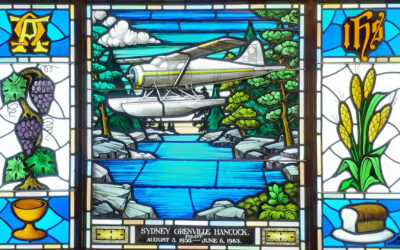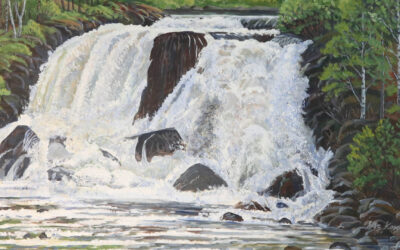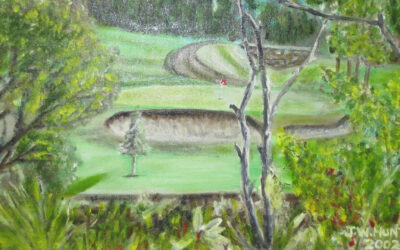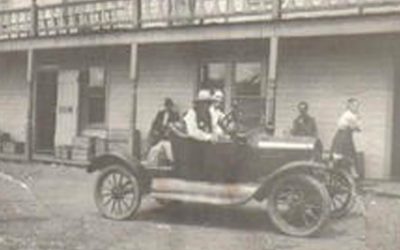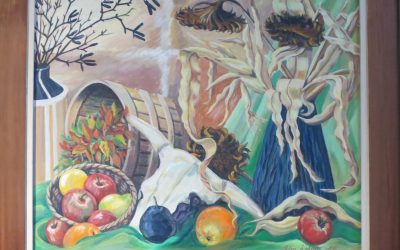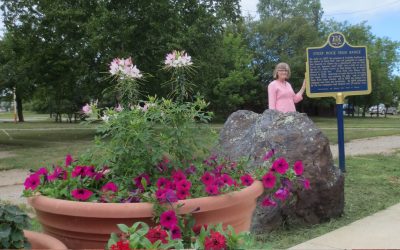The Challenge of Teaching
 It was 1925, and as Andrew Clement explained in “The Bell and the Book” he needed a teaching position, and the community around Miscampbell School Section No. 1 needed a teacher. In describing his first teaching experience, readers are taken back in time to the stark reality of a one room school. Clement taught at Miscampbell, a community west and north of Fort Frances, for two years.
It was 1925, and as Andrew Clement explained in “The Bell and the Book” he needed a teaching position, and the community around Miscampbell School Section No. 1 needed a teacher. In describing his first teaching experience, readers are taken back in time to the stark reality of a one room school. Clement taught at Miscampbell, a community west and north of Fort Frances, for two years.
Andrew Clement boarded with the the Smeeth family and he corresponded with them annually after he left Miscampbell. Jesse and Maude Smeeth were Ruth Vidall’s parents. Some of the photographs in this section were supplied by Ruth’s older sister Mildred Smeeth. Clement recounts his time with the Smeeth family with genuine appreciation and warmth, an invaluable insight into that period of teaching. Clements account is entertaining, describing continual scrutiny by the community and the expectations of the parents.
In his words the school was “neat, frugally constructed with nothing to spare, and according to regulation, just enough floor space per pupil.” About half the west wall was windows, the light from which reached the far wooden blackboards even on the dullest days. (no electrical lighting) Those same windows added needed warmth from the sun on cold winter afternoons. The wood stove situated 6 feet from the back door, and fired with dry tamarack, was sufficient to heat the school, but the windows were not snugly sealed!
Every day started with sounding the hand bell. The teacher was required to integrate little children into the awesome process of education and prepare older students to meet the requirements of the Entrance Examinations. Those examinations were set by principals of town schools so distant they could not imagine the challenges for teachers in remote areas. The minimum requirement for all schools was weighing scales, maps, charts, library books, a series of liquid measurements, a standard dictionary, a Bible and of course a hand bell. Teachers were evaluated by the superintendent who used the “Programme of Studies for Grades 1 to 6” issued by the authority of the Minister of Education. A quick look at the introduction and the subtitle “Education for Democratic Living,” highlights the rigorous rules and austere moral codes under which teachers taught.
It is worth contemplating the challenges of those times, the years between 1900 and 1950. As I studied the artifacts and teaching manuals of those early years, the challenges both personal and intellectual for teachers, the full impact of the second 50 years became clear. In the 1950s the school system evolved and teacher training expanded. After the sheer drudgery and loneliness of the one-room school changes were more than needed.
The Atikokan Museum welcomes visitors Monday to Friday, 10 am to 4 pm. The exhibit “Inspired Teaching includes profiles of Atikokan teachers. Their teaching experience and memories are valuable history, and like Andrew Clement’s writing takes the reader behind the scenes into the very important work of education. Very welcome are additions to this collection of Atikokan history.
More Articles
Illuminated Wall Decorations – Atikokan History
The latest addition to the Writer’s Nook in the Museum of Atikokan is a beautiful stained-glass window. The window is illuminated by a specially constructed cabinet to accommodate LED lighting with a diffusion layer, crafted by Dutka Signs. This beautiful window...
Waterfalls and Water Scenes
Waterfalls and water scenes are a favourite subject of artists and photographers. Thursday, August 12th, 2 to 4 pm our exhibit in the green space beside the Library will feature waterfalls and water scenes by Elsa Kosola, Mary Bordynuik, Elaine Kryzanowski, and...
Mystery Painter and a Favourite
There are two paintings by “Markell” in the Museum collection and no records to tell us about the painter. One painting includes the sign for Leishman's Pharmacy, which was at 208 O'Brien Street according to our records. Visible in the distant background is the dome...
Artists in the Park
One of the strengths of Atikokan's museum is the fine art collection. There have been many Atikokan artists, some very well known, others not so much. In the early 1950s Mari Hegler formed the Atikokan Art Club. It was an ambitious and hard working group with a...
April 2021, 23rd National Poetry Month
Slam poetry, spoken word poetry and rap are the trends of today. Poetry has always been a popular outlet. I have found many poems working with the archival materials in the Atikokan Museum. Some bring a chuckle over the wit and humour, others are touching. It is the...
French River Spring by Jameson Kooper
Published in Lone Pine North Woods by Jameson Kooper, 2017 French River Spring Tender shootsRise to feast upon Aten`sGold, breaking soilLong held in winter blanket. With each dew day, glintingJewels wake a sleepy world,Shaking spiders from cobwebs,Ants from dens,As...
First Ford Car in Atikokan
Mr. C. W. Palmer driving his car in front of the Atikokan Hotel, June 1921 The poem, "For Sale" transcribed below, is from a hand written document, a faded piece of lined paper, likely taken from a "scribbler". The distincitive writing, in faded India ink, is composed...
Harvest Still Life Painting by Elsa Kosola, 1986
Still life paintings offer a new way of looking at the ordinary objects. The goal of still life composition is to direct the viewer's eye through a painting and lead them to what the artist thinks is important. This type of artistic exercise has a long history....
It’s in her blood
It's in her blood .... Alanna Marohnic offering drawing classes at the Museum I am certain that teachers, friends and many others in Atikokan can recall images of little Alanna, a creative force sketching, painting, adventuring into the world of art. Now an artist...
Fresh look for Ontario Heritage Trust Plaque
The Archaeological and Historic Sites Board of Ontario marker for Steep Rock Iron Range was faded and weather beaten. When contacted Ontario Heritage Trust provided the necessary information and permission to restore the marker. Historical markers serve to educate and...

